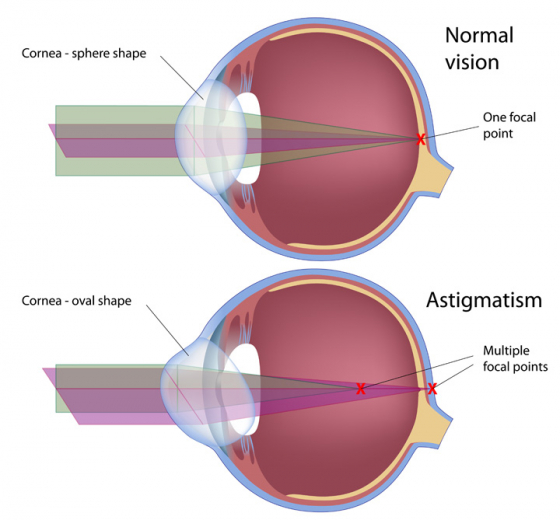Astigmatism is a minor eye condition that occurs when the curvature of the cornea or the eye’s lens isn’t symmetrical. Wearing glasses for astigmatism is a common way to correct the condition. If you already wear corrective lenses, you might already have astigmatism to some extent.
Glasses for astigmatism are usually associated with two conditions; myopia and hyperopia, which are also known as refractive errors. Astigmatism is usually present from birth, but can develop at any time throughout your life and will be diagnosed in a routine eye examination.
Most people’s eyes are round and shaped like a football. If you have astigmatism, it means your eye is shaped more like a rugby ball.

DO YOU NEED GLASSES FOR ASTIGMATISM?
There are two types of astigmatism, regular and irregular. Regular astigmatism occurs when the cornea is curved more in one direction and can be treated with a range of lenses, including glasses and contact lenses. Irregular astigmatism occurs when the cornea is uneven and curved in a number of directions. This could be the result of an eye injury which has led to a scar on the cornea. Irregular astigmatism can only be corrected with contact lenses.
If you notice symptoms such as blurred near or far vision, difficulty distinguishing shapes and details, or frequently experience headaches, eye strain or fatigue, it is likely you have some degree of astigmatism.
When you have astigmatism light focuses on more than one area of the retina and so your vision will appear distorted. Wearing glasses for astigmatism can compensate for the cornea’s irregular curve.
If you are trying to identify if you have astigmatism on your lens prescription, you will find it under Cylinder (CYL). If there is nothing in this column, you don’t suffer from astigmatism.
HOW TO CHOOSE GLASSES FOR ASTIGMATISM
Glasses for astigmatism are optimised to treat a refractive error, such as myopia or hyperopia. Your vision needs will affect which glasses you are required to wear. Of course, you may also suffer from presbyopia and have astigmatism.
By attending regular eye examinations, your optometrist will be able to tell you whether you are short-sighted or long-sighted, or a mixture of the two. Your optometrist can also identify how severe your astigmatism is to ensure you are wearing glasses for astigmatism that are tailored to you.
Astigmatism will not cure itself and may even progress with age. Glasses for astigmatism are the most common way to alleviate the symptoms. Uncorrected astigmatism may lead to a lazy eye in children, so it’s important to take your child for regular eye examinations too.

Glasses for astigmatism can help you to see clearly again. You will likely either need single vision lenses or varifocal lenses depending on which refractive error you have. Wearing the right glasses for astigmatism will help the light to pass through the lens and focus on the retina in the correct place to deliver a sharp image.
Choosing glasses for astigmatism may depend on your personal preference and lifestyle. For instance, if you often use digital devices for work or socialising, you may wish to invest in Eyezen lenses; single vision lenses that can correct myopia or hyperopia and astigmatism, while being optimised for protection from pixelated screens.
If you require varifocal lenses, Varilux X series lenses can provide smooth transitions between vision zones and reduce image distortions by correcting presbyopia and astigmatism.
EXPLORE LENS SOLUTIONS FOR ASTIGMATISM




